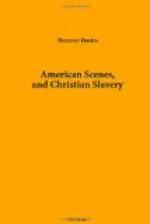At 5 P.M. we passed Owensborough, on the Kentucky side of the river. This, too, is a neat little town, with a proportionate number of places of worship. Indeed, on every hand, places of worship appear to rise simultaneously with the young settlement. The free and efficient working of the voluntary principle is the glory of America. In reference to “church” accommodation, it everywhere appears to decided advantage compared to the most favoured parts of England. On this subject Dr. Baird’s book on Religion in America is very truthful.
The fever left me on entering the Ohio, and returned no more,—a clear proof that this river is healthier than the Mississippi. The latter has much fog and malaria, which tell quickly upon a constitution like mine, already predisposed by residence among the swamps of Guiana to fever and ague.
As I have already intimated, we had now Indiana, a free State, on our left. This State is rapidly advancing in wealth and population. It was settled by the French in 1730, and became an independent State in 1816. It has an area of 36,840 square miles, being by two-fifths less than its neighbour Illinois. Its population at the beginning of this century was only 5,640; in 1840 it was 685,860. It is now above a million! In 1840 it produced upwards of four millions of bushels of wheat, and twenty-eight millions of corn!
February 20.—The scenery was diversified. Hills covered with trees rose on either side. In the summer, when all is fresh and green, there must be here scenes of loveliness and grandeur unsurpassed. At present the country had a cold and winterly aspect. It rained, too, the whole day. At 3 P.M. we approached New Albany, on the Indiana side. It is a flourishing place, with from 5,000 to 6,000 inhabitants. Just above this town are some falls in the Ohio, that can seldom be ascended by steamers, which therefore pass through a side canal, with locks, formed (through the superior influence of the slave-power) on the Kentucky or slave bank of the river. We had to pass through three locks, which have been very foolishly made too small to receive steamers of the largest class in the navigation of the Ohio. Ours fortunately, not being of that class, could “go a-head.”
At 5 P.M. we got to Louisville, a city of about 30,000 or 40,000 inhabitants, on the Kentucky side. This city is a great depot for slaves, whence they are shipped for the New Orleans market. By this means it has acquired a detestable notoriety.
“A trader was about to start from Louisville, Kentucky,” says the Anti-Slavery Record, “with one hundred slaves for New Orleans. Among them were two women, with infants at the breast. Knowing that these infants would depreciate the value of the mothers, the trader sold them for one dollar each. Another mother was separated from her sick child about four or five years old. Her anguish was so great that she sickened and died before reaching her destination.”




